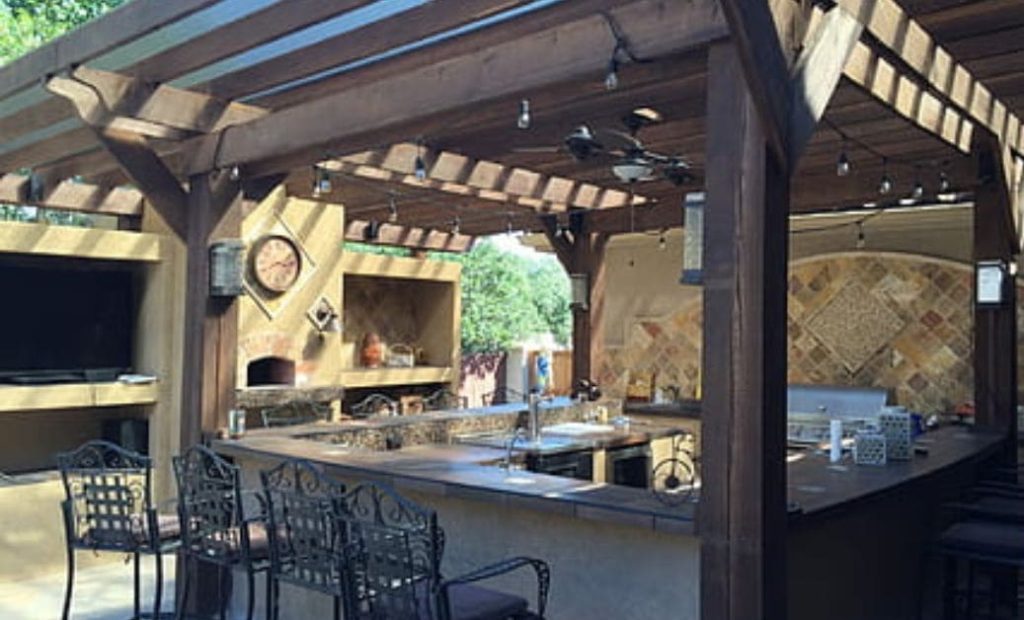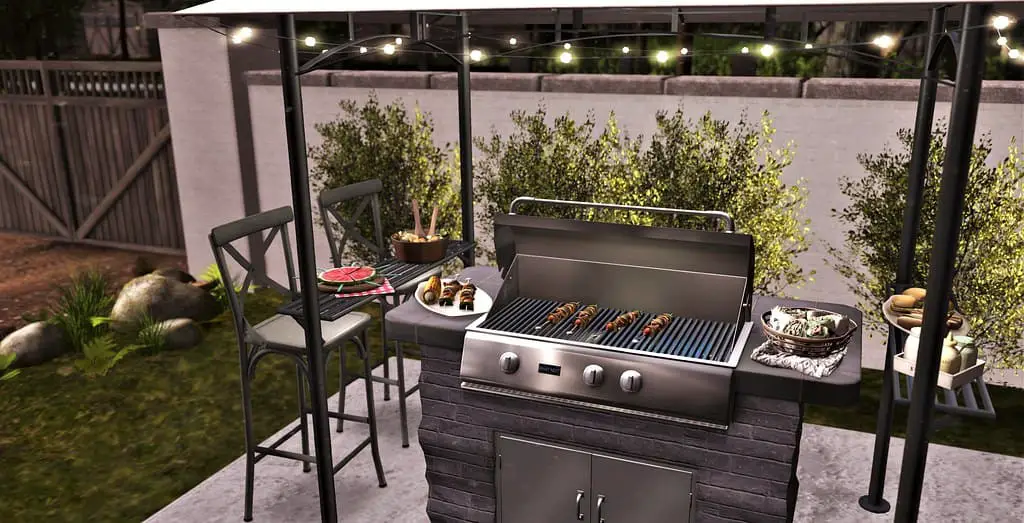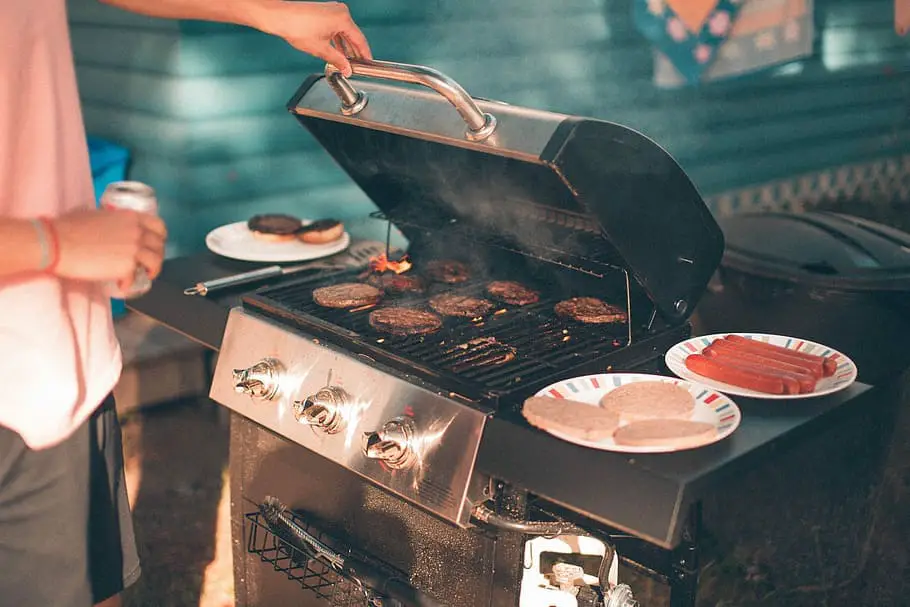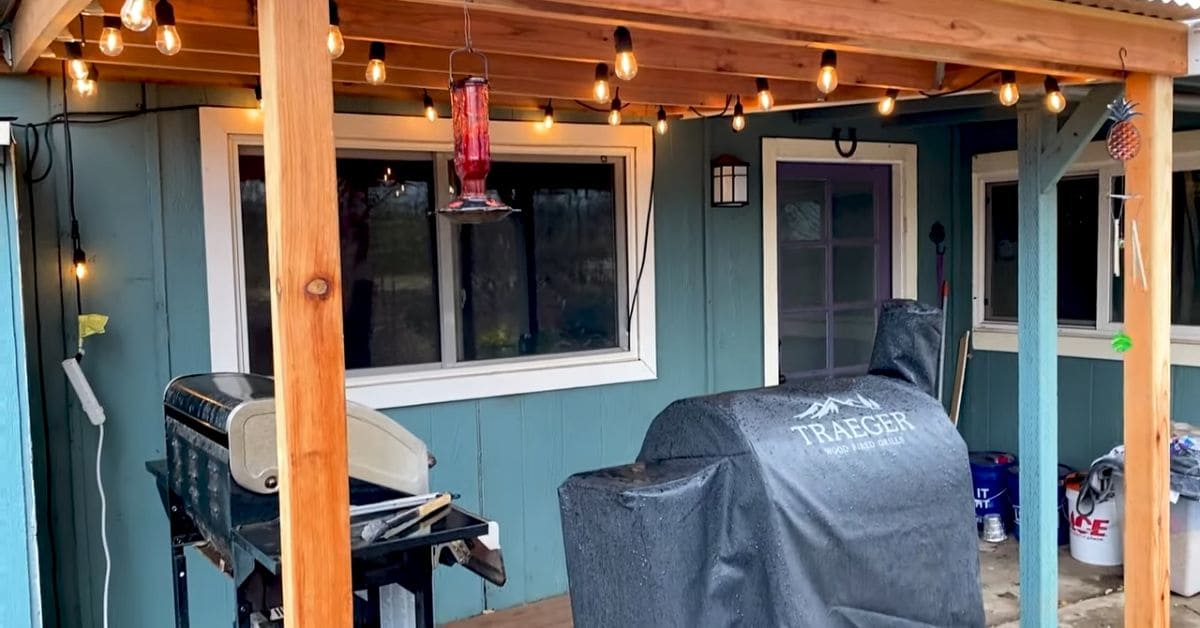I’m often asked about the safety of using gas grills on covered porches. After careful consideration and taking necessary precautions, I can confirm that it is possible to safely use a gas grill on a covered porch.
The convenience of grilling with gas, thanks to its speed and effectiveness, is undeniable. However, it’s important to be aware that there are potential risks involved.
Therefore, it’s crucial to take precautions to ensure the safety of anyone or anything in the surrounding area.
In this article, I will provide you with comprehensive guidelines on whether can you put a gas grill under a covered porch. so you can enjoy the convenience of grilling without compromising safety.
Can You Put a Gas Grill Under a Covered Porch: Yes, it is possible to safely use a gas grill under a covered porch with proper precautions. Grilling with gas is fast and convenient, but it comes with potential risks.
Can You Put a Gas Grill Under a Covered Porch: A Short Guide

Sometimes, grilling outdoors can be challenging due to weather conditions like heavy rains, strong winds, scorching sun, or even heavy snowfall.
That’s why many people consider using a covered porch for grilling. Yes, you can place a gas grill under a covered porch to provide shelter.
However, it’s important to follow some precautions. Make sure there is enough ventilation and keep the covered area at a safe distance from the open flame.
It’s crucial to use gas grills and flames as intended to avoid any safety hazards.
Is it Safe to Grill Under an Awning?
Awnings are typically made of fabric that can resist flames from sources like candles or lamps. However, they are not designed to withstand the high temperatures generated by grilling.
It is not recommended to grill under an awning if the distance between the grill and the awning is less than 3 feet, or if there is no other barrier like a brick wall or masonry surface in between.
Safety precautions should be taken to avoid any potential hazards.
Understanding Clearance Requirements for Gas Grills:
According to the NFPA (National Fire Prevention Association), it’s recommended to keep a gas grill at least 10 feet away from any flammable objects and 3 feet above them. However, this is just a guideline and not a strict fire code.
It’s important to check with your building department, as they may have additional regulations, such as maintaining a certain distance between the grill and the railing. Ensuring proper clearance between the grill and surrounding objects is crucial for fire safety.
Risks and Safety of Gas Grill Explosions:

The type of grill you use will determine the safety considerations. Gas grills are popular for their convenience, as they don’t require lighter fluid or charcoal. However, gas grills can be dangerous if not used properly.
Propane tanks, when combined with an open flame, can potentially explode under certain conditions. A leak in the tank due to faulty equipment can lead to an explosion if not addressed.
It’s important to be aware of these risks and take appropriate precautions to prevent any accidents or explosions related to gas grills. Safety should always be a top priority when using any type of grill.
Grilling Safety: Can You Grill Under a Tree?
If you want to grill under a tree, make sure your grill, whether gas or charcoal, is at least 10 feet away from large plants or flammable structures. While trees provide shade, they may not be the safest location for grilling.
On windy days, overhanging branches can easily catch fire, posing a risk of spreading flames. It’s important to ensure proper distance from trees and other flammable objects when grilling to minimize the risk of accidents or fires. Safety should always be a priority when setting up a grill in any location.
What Gas Grill is recommended for use on a covered patio?
When looking for the best gas grill for your covered patio, consider your cooking needs and available options. Two recommended grills for indoor or covered patio use are the Weber Spirit E210 3000 Series Liquid Propane Gas Grill and the Char-Broil Classic 360 Grill.
These grills are known for their performance and durability, making them ideal choices for cooking comfortably in your home or under a covered patio.
Weber Spirit E-210 Gas Grill: 2-Burner, Liquid Propane – A User-Friendly Guide
The Weber Spirit E210 gas grill has two burners that can be adjusted to different heat levels, providing a total of 81,000 BTUs of cooking power.
It offers a generous cooking space of 629 square inches, making it suitable for cooking large quantities of food.
The grill also features convenient electronic ignition and a porcelain-coated grate for easy cleaning. Additionally, it comes with side shelves for added convenience during cooking.
Char-Broil Classic 360 Gas Grill | 3-Burner with Side Burner, Propane
The Char-Broil Classic 360 gas grill is a great choice for cooking on covered patios. It has a compact and portable design, making it easy to move around. The grill is sturdy with five burners that can generate up to 29,500 BTUs of heat.
It also features an extra-large side shelf for convenient food preparation while cooking. This eliminates the need to juggle ingredients on limited counter space.
What is the recommended distance for placing a grill in relation to your house?

According to building codes in most jurisdictions, the recommended distance between a freestanding grill and a house is 10 feet. However, it’s important to follow local regulations and ensure that your grill is positioned far enough away from your house to prevent the risk of fire spreading and causing damage to your buildings or home.
Although not mandatory in all areas, this guideline is commonly followed in places governed by the International Building Code.
Risks of Using a Gas Grill Under a Covered Porch
There are several safety risks associated with using a gas grill under a covered porch. These risks can be dangerous as gas is flammable, and when combined with an enclosed space and combustible materials, it can lead to disaster. The potential risks include:
Fire Hazards Associated with Gas Grilling:
There is a risk of fire when gas grills are left running accidentally or used too close to flammable materials. According to the National Fire Prevention Association, gas grills were involved in 84% of home fires caused by gas. It is crucial to use and maintain gas grills safely, and to keep them away from anything that can explode or catch fire.
Dangers of Carbon Monoxide Poisoning from Gas Grilling:
Carbon monoxide is a harmful chemical that is produced when natural gases are not burned properly. This can happen due to faulty products or improper usage of gas grills.
Carbon monoxide poisoning can occur when these gases are trapped in an area with poor ventilation, and people or animals are present and unknowingly inhale it.
Carbon monoxide poisoning can cause various symptoms, such as headaches, dizziness, weakness, upset stomach, vomiting, chest pain, and confusion.
In severe cases, it can cause loss of consciousness or even death. It’s important to be aware of these symptoms and take immediate action if you suspect carbon monoxide poisoning.
Risks of Gas Leaks during Grilling Under a Covered Porch:

Gas leaks can be dangerous as they can cause serious harm to people and property. The challenge is that gas leaks are often hard to detect, as they may not be visible and the smell of gas may not always be noticeable to everyone. Leaks can happen due to faulty hoses or poorly maintained joining parts.
These leaks can lead to hazards such as carbon monoxide poisoning or explosions, among other serious outcomes. It’s important to ensure proper maintenance and take precautions to prevent gas leaks and their potential risks.
Best Practices for Safe Gas Grilling Under a Covered Porch
Using a gas grill under a covered porch or patio can be convenient, but it’s important to follow some safety tips to ensure a safe grilling experience. Here are some easy-to-follow precautions:
Safety Recommendations from the Grill Manufacturer:
Always make sure to read and follow the installation instructions and manufacturer’s guidelines when setting up and using your grill. These instructions are designed to ensure your safety. By carefully following them, you can minimize the risk of any potential issues, unless there is a defect in the product.
Maintain Safe Distance from Walls and Surfaces:
Gas grills generate a lot of heat quickly, and it can be intense. It’s crucial to keep walls and surfaces at least 10 feet away from the grill to prevent them from getting burnt, melted, or damaged due to the high heat. Ensuring proper clearance around the grill is essential for safety.
Ventilation Properly Ensured:
If a gas grill is used in an area with poor ventilation, natural gases like carbon monoxide can accumulate quickly. Inhaling too much of it can cause loss of consciousness or even death.
Additionally, if the concentration of gas reaches a certain level and mixes with oxygen, it can explode. Proper ventilation is crucial to prevent these risks.
To avoid the risks of gas leaks and poor ventilation, it’s important to ensure that the grill is used in well-ventilated areas and not left running unnecessarily.
Keeping a 10-foot clearance around all sides of the grill and placing it in an open space can help prevent ventilation problems and reduce the chances of gas-related accidents.
Grill Maintain & Check Regularly:
It’s a good idea to clean your grill thoroughly every 5-10 uses, especially if it’s used frequently. However, it may not always be possible to do so after each use.
As an alternative, make sure to clean and maintain all the moving parts of the grill at least twice a year. This includes inspecting the gas lines, changing the gas, and checking the ignitor to ensure they are in good working condition.
Is it safe to place a Gas Grill in close Proximity to a house?
According to the American Red Cross, it’s important to keep your grill, whether it’s charcoal or gas, at least 10 feet away from deck railings and any structures like your home, garage, or sheds. This allows for enough space to ensure safety during grilling activities.
Is it safe to use a Gas Grill under a canopy?
We strongly advise against using any flame, such as a grill or stove, under a canopy tent. It can be dangerous and result in damage to your equipment.
If you still choose to cook under a canopy tent, make sure to select an area that is far away from any nearby objects, so that if the shelter catches fire, the flames won’t spread easily.
Alternative Options for Grilling in a Covered Porch
If you’re concerned about the safety of using gas as fuel for your grill, there are other options available. The two most common alternatives are electric and charcoal grills.
Each option has its own pros and cons, so it’s important to understand their usage styles and determine if making the switch is worthwhile. Let’s take a closer look at both of these fuel sources and compare them.
Grilling with Charcoal:
Here are some pros and cons of Charcoal Grills:
Pros:
- Do not produce carbon monoxide
- Can reach extremely high heat with no maximum temperature
- Allow for a variety of cooking styles (direct, indirect, etc.)
- Provide amazing smoky flavor
- Less expensive to run
Cons:
- Extreme temperatures can potentially damage nearby objects and structures
- Create a lot of smoke
- Charcoal can burn out quickly, requiring regulation of cooking times and charcoal addition
- Can be difficult to clean due to ash removal
- The quality of charcoal can vary
Grilling with Electric:
Here are some pros and cons of electric grills:
Pros:
- Does not produce carbon monoxide.
- Convenient quick start.
- Safe to use in a wide range of areas, including indoors, outdoors, and under a covered porch.
- Safety cut off features.
- Easy to control temperature.
- Easy to clean and requires less general maintenance.
Cons:
- Requires electricity to run, which may not be available during all outdoor experiences.
- The flavor may not be as prominent as with smoky charcoal or gas options.
- May use a decent amount of energy to run, depending on the grill style.
Factors to Consider when Put a Gas Grill under a Covered Porch
Important Factors to Consider When Placing a Gas Grill Under a Covered Porch:
Weather Conditions:
When placing a gas grill under a covered porch, it’s important to consider the weather conditions in your area. If your covered porch is exposed to heavy rain, snow, or extreme temperatures, it may affect the performance and longevity of your gas grill.
Exposure to harsh weather conditions can cause rusting, corrosion, and other damage to the grill. Consider the durability and weather resistance of your gas grill and choose a location under the covered porch that provides adequate protection from the elements.
Ventilation:
Proper ventilation is crucial when using a gas grill under a covered porch. Gas grills produce smoke, heat, and fumes that need to be properly ventilated to ensure safe operation.
Make sure that your covered porch has adequate ventilation openings or vents to allow for proper airflow. Without proper ventilation, gas fumes and smoke can accumulate, posing a health hazard and increasing the risk of fire.
Clearance from Combustible Materials:
When placing a gas grill under a covered porch, it’s important to maintain proper clearance from combustible materials. Combustible materials include walls, roofs, furniture, curtains, and other objects that can catch fire.
Check the manufacturer’s guidelines for the recommended clearance distances between the gas grill and combustible materials. It’s important to ensure that there is enough space to prevent accidental fires and to allow for the safe operation of the gas grill.
Local Building Codes and Regulations:
Before placing a gas grill under a covered porch, it’s important to check your local building codes and regulations. Building codes may have specific requirements for the installation and use of gas grills under covered porches to ensure safety.
Make sure to comply with all relevant local codes and regulations to avoid any legal or safety issues. It’s also a good idea to consult with a qualified professional, such as a contractor or fire safety expert, to ensure that you are meeting all necessary requirements.
Pros and Cons of Putting a Gas Grill Under a Covered Porch:
Here we will discuss the pros and cons of putting a gas grill under a covered porch:
Pros of Putting a Gas Grill Under a Covered Porch:
Here are some pros of putting a gas grill:
- Protection from Weather:
Placing a gas grill under a covered porch can provide protection from rain, snow, and extreme temperatures, allowing you to grill year-round without being affected by the weather.
- Convenience:
Having a gas grill under a covered porch can provide convenient access to your grill, especially during inclement weather, as you can still use it without having to go outside.
Cons of Putting a Gas Grill Under a Covered Porch:
Here are some cons of putting a gas grill below:
- Ventilation Concerns:
Gas grills produce carbon monoxide and other potentially harmful gases during operation. If the covered porch lacks proper ventilation, these gases may accumulate, posing a safety risk.
- Clearance of Combustible Materials:
Gas grills require adequate clearance from combustible materials, such as walls, ceilings, and furniture, to prevent fire hazards. Placing a gas grill too close to a covered porch may increase the risk of fire.
- Local Building Codes & Regulations:
Local building codes and regulations may prohibit or restrict the use of gas grills under covered porches. It’s essential to check and comply with any applicable regulations to ensure safety and avoid potential fines or penalties.
It’s important to carefully consider these factors before deciding to put a gas grill under a covered porch to ensure the safety of your home, property, and those around you.
It’s recommended to consult with a qualified professional, such as a contractor or local authorities, for guidance on proper installation and adherence to local codes and regulations.
Safety Precautions
When using a gas grill, it’s important to follow safety precautions to ensure safe and enjoyable grilling experiences. Here are some essential safety precautions to keep in mind:
- Proper Ventilation:
Adequate ventilation is essential when using a gas grill under a covered porch. Ensure that the covered porch has proper ventilation to allow for the safe dispersal of gas fumes and prevent the buildup of potentially harmful gases, such as carbon monoxide. This may include having open sides or a vented roof in the porch area.
- Clearance from Combustible Materials:
It is critical to maintaining proper clearance from combustible materials when placing a gas grill under a covered porch. Keep the grill at a safe distance from any flammable objects, such as walls, railings, overhead structures, and furniture.
Follow the manufacturer’s instructions for recommended clearance distances to minimize the risk of fire.
- Adherence to Local Building Codes and Regulations:
Check and adhere to local building codes and regulations when installing and using a gas grill under a covered porch. Some areas may have specific requirements for the use of gas grills in covered spaces, including ventilation, clearance, and installation guidelines.
Familiarize yourself with these regulations and ensure compliance for safe and legal operation.
- Regular Maintenance, Inspection, and Cleaning:
Regular maintenance, inspection, and cleaning of the gas grill and the covered porch are crucial for safe operation. Keep the grill clean from grease, debris, and accumulated residue to reduce the risk of fire.
Regularly inspect the gas connections, hoses, and burners for any signs of damage or wear and address them promptly. Follow the manufacturer’s recommended maintenance schedule and guidelines for safe and efficient operation.
- Proper Use of Gas Grills:
Always follow the manufacturer’s instructions for the proper use of your gas grill. Never leave the grill unattended while it is in use, and always ensure that it is turned off after cooking.
Keep a fire extinguisher nearby and know how to use it in case of an emergency. Avoid any unauthorized modifications or alterations to the gas grill and its components.
By following these safety precautions, you can minimize the risks associated with using a gas grill under a covered porch and ensure safe and enjoyable grilling experiences.
FAQs:
Q:1 What is the recommended overhead clearance for a gas grill?
To safely use a gas grill, you should make sure there is at least 60 inches (1524 mm) of space between the grilling surface and any overhead construction, like a roof or awning.
If you’re installing the grill under a combustible overhead construction, you need to cover the area above the cooking surface with an exhaust hood to prevent any potential fire hazards.
Q:2 How much clearance should be maintained around a grill for safety?
Make sure there is enough space around your grill to keep it safely away from anything that can catch fire. Follow the manufacturer’s guidelines, which usually suggest leaving at least 20 inches of space behind the grill, 7 inches on the sides, and 24 inches if the grill is near vinyl siding. This will help prevent any potential fire hazards and ensure the safe operation of your grill.
Q:3 Is it safe to operate a gas grill under a carport?
It’s not recommended to use gas or charcoal grills under covered areas because there may not be enough airflow to safely vent the smoke and fumes. It’s important to make sure all the smoke and fumes can safely dissipate.
However, electric grills are safe to use under a carport because they don’t produce any gases or fumes that need to be vented.
Q:4 Can a propane grill be used safely under an awning?
If your awning is installed at the right height and your grill is well-maintained, then it’s safe to use a propane grill under an awning. Just make sure to clean your grill before using it to avoid excess grease and flames.
When you’re getting your awning installed, let your professional designer know that you plan to place your grill under the awning for cooking.
Q:5 What is the proper placement of a gas grill on a patio to ensure safety?
When setting up your grill, make sure it’s on a flat and clean surface, away from any debris like trash bins or mulch that could catch fire. Also, avoid placing your grill near low-lying trees or hedges.
Check for any low-hanging branches around your BBQ and make sure there are none nearby to prevent any fire hazards.
Conclusion:
In conclusion, while it is technically possible to place a gas grill under a covered porch, it is generally not recommended due to potential safety risks. Gas grills produce heat, smoke, and fumes that need proper ventilation to dissipate.
Under a covered porch, there may be limited airflow, which can result in the accumulation of smoke and fumes, posing a fire hazard or health risk.
The risk of fire increases if the covered porch has combustible materials or if the grill is placed too close to walls, ceilings, or other flammable objects.
Additionally, gas grills require regular maintenance, including cleaning and inspection, to ensure safe operation. Limited space and restricted access under a covered porch may make maintenance more challenging.
It is always best to follow the manufacturer’s guidelines and local building codes when placing a gas grill.
If you are considering using a gas grill under a covered porch, consult with a qualified professional, such as a licensed contractor or grill manufacturer, to ensure proper installation and safety measures are in place.
Alternatively, considering alternative grilling options, such as electric grills, which do not produce smoke or fumes, may be a safer choice for grilling under covered porches.
Prioritizing safety and proper ventilation is crucial when it comes to using gas grills under covered porches to prevent any potential hazards.
We hope you will be well aware of “Can you put a gas grill under a covered porch?”, after reading this comprehensive article. If you have any questions, feel free to comment below!

